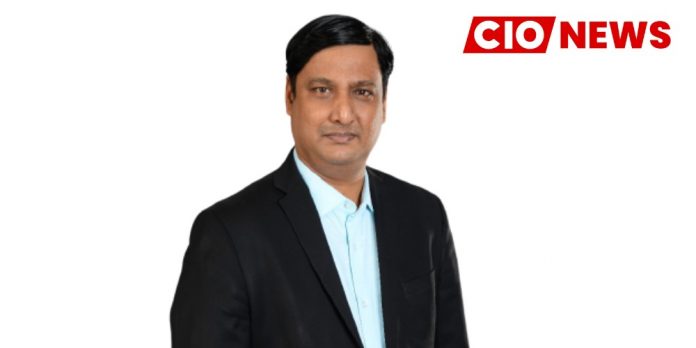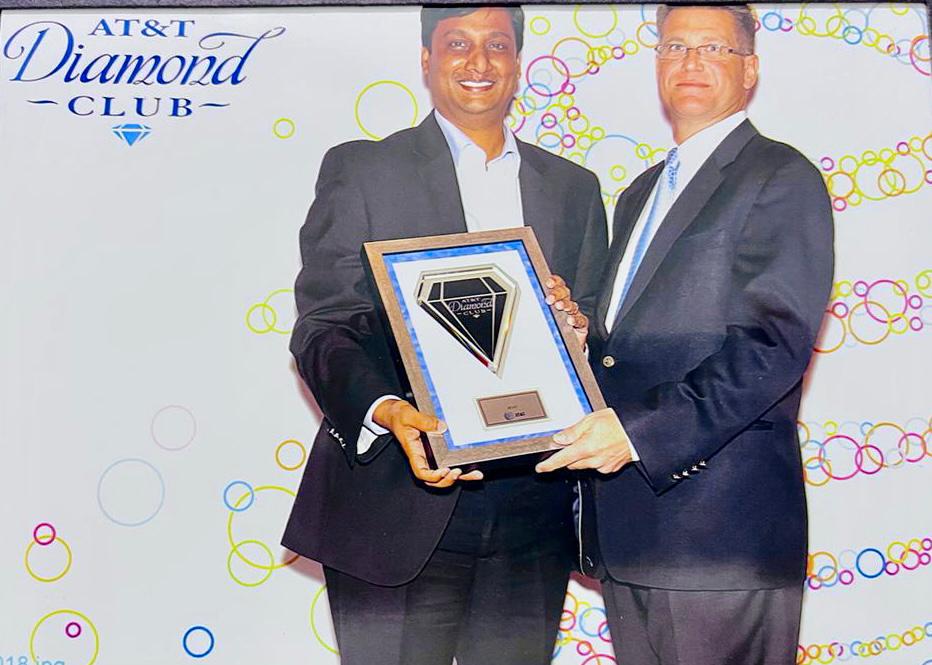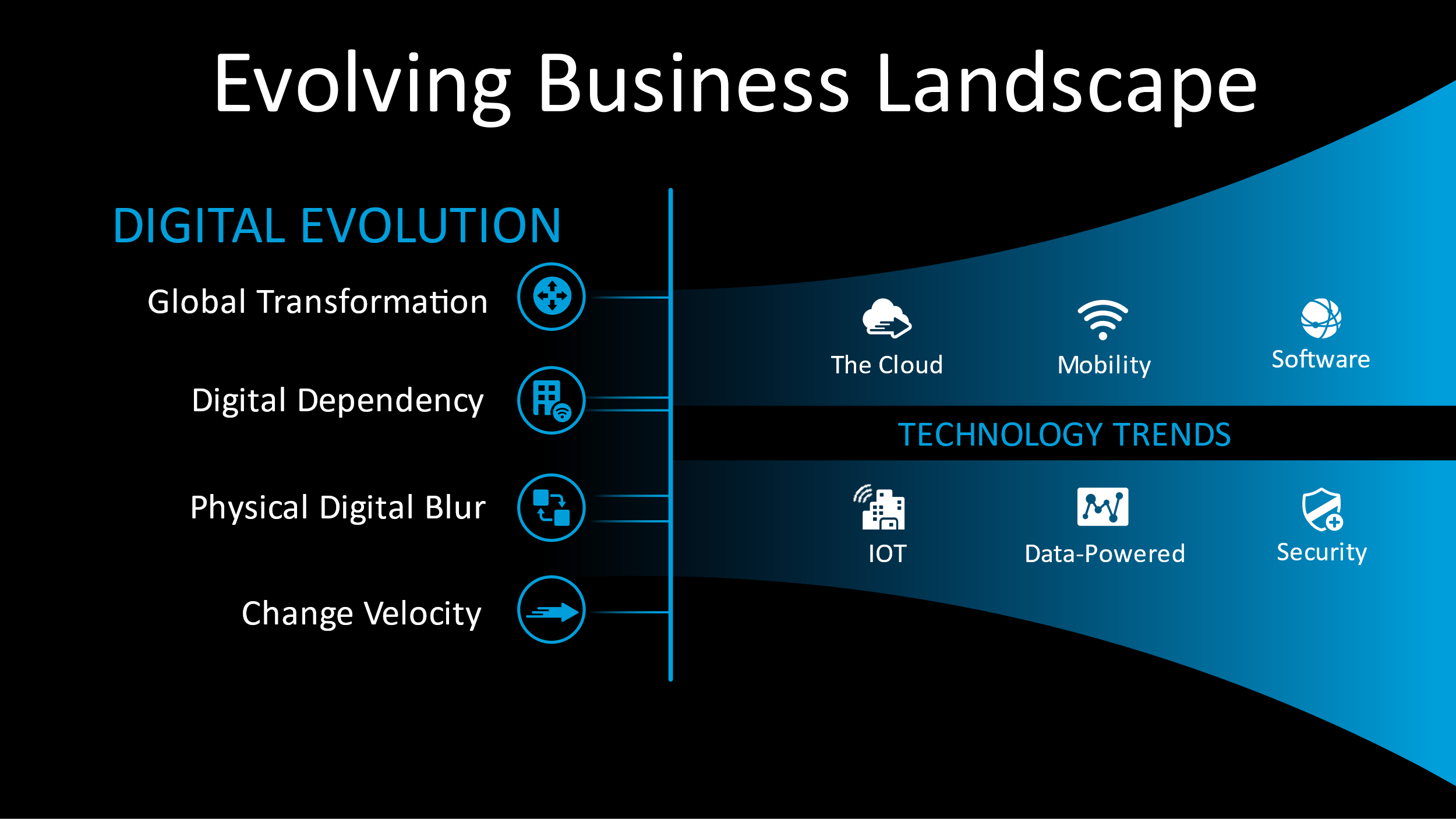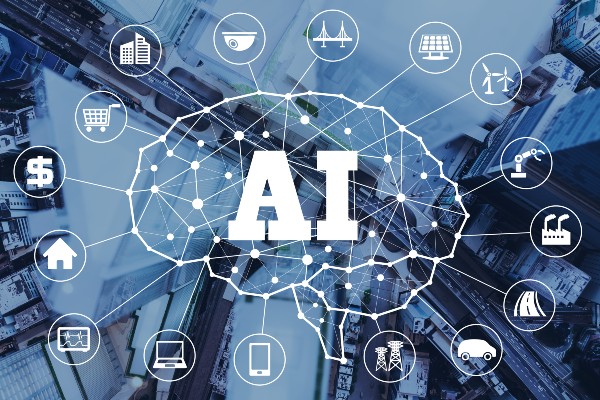
Digital transformation is not about technology but about people. The seamless integration of People, Processes, and Technology is paramount
When asked how he planned his career path to be a successful Regional Director – IoT, Sunil David, Regional Director – IoT (India and ASEAN region) at AT&T, in an exclusive interview with CIO News, said, I started my career way back in January 1994 when I joined a small private firm called Cygnus Microsystems, Hyderabad as a Sales and Marketing Executive. Cygnus products were used by the Indian Railways to connect their large Mainframe Computers in the major Metropolitan cities to large reservation terminals spread across India. I had the opportunity to travel to many parts of India to install Cygnus products. During the mid-1990s, we started to see Local Area Networks adoption amongst companies and a clear trend of companies moving from Centralised computing and networking environments to more Client-Server architectures.
After a brief stint with CMS Computers Ltd, a Mumbai-based firm where I was responsible to sell LAN and WAN Solutions to large Indian corporates and PSUs, I moved to the Telecom industry. During my CMS stint, I started to develop an interest in Networking and Connectivity. The Government of India had also privatized the Telecommunications sector in 1994 and allowed private players to offer fixed-line, Cellular, VSAT satellite communication services, paging services, etc.
In May 1996, I had the first opportunity to join the Telecommunications Industry when Telstra V-Comm a JV between Telstra, Australia and VSNL (Govt. Of India owned at that point in time) started to offer VSAT Communication services to large Indian Conglomerates and Govt. PSUs. I was responsible for Installation and Support in my first couple of years and later on moved to Sales. During the first couple of years, I had the opportunity to install VSATs for many large Indian corporates like Pepsi, Ford India, Mahanadi Coal Fields, etc. at many remote locations in India.
After a four-year stint with Telstra V-Comm, I joined Polaris Software Ltd as a Marketing Manager for a year where Polaris in partnership with IIT Madras was building a Network Management System for private Telecom players to manage the network.
In October 2001, I joined AT&T India, the first opportunity for me to work for a large American Telecommunications MNC as a Strategic Account Manager responsible for the state of Tamil Nadu and tasked with positioning and selling AT&T International Private line services initially and later on to sell their Private VPN, end-to-end VPN services to TN-based Enterprises, wanting to connect their offices spread across Globally through a Private network. We had barely a few customers in Chennai when I joined and by 2007, I had ensured that we grew our customer base significantly. In the middle of 2007, I was promoted as the Regional Sales Head for a part of the Southern region and had a small team to manage. AT&T’s portfolio of service offerings to Indian customers started to increase and by late 2015, I had ensured through the support of my team that the region which I managed contributed significantly to AT&T’s overall India revenues. During this period, my team and I handled multimillion-dollar relationships with very large Indian System Integrators.
Right since I joined AT&T India in 2001, I always used to attend Industry events organized by bodies like CII, NASSCOM, etc. and was keen to hear insights from the Industry leaders and also to get a sense of the technology trends that were prevailing at that point in time. My interest to learn and constantly keeping updated with the latest in Global Technology trends even triggered a couple of International trips I made at my own cost. I had a wonderful experience attending the Mobile World Congress (MWC) in Barcelona in 2013 and the Consumer Electronics Show (CES) in Las Vegas in Jan 2014. It was around this time when M2M or Machine to Machine communications was being talked about and how IOT being a subset of it will in the future transform Industries. M2M/IOT caught my interest from 2013 onwards and I started to attend M2M/ IOT Events in India frequently at my own cost. AT&T also had limited offerings in the IoT space at that time and I used to thoroughly enjoy trying to position this to some of the prospective customers.
During my 14 years stint with India, I had won a number of Global, Regional and India-initiated awards. I was also nominated for a Global Leadership Program in 2009 as I was recognized as a High potential leader and had travelled to the US in mid-2009 to participate in a short Leadership program which had participation from Leaders from other countries joining as well.
Amongst all the multiple awards and recognitions that I won during my AT&T India stint, there are two awards that are close to my heart and will always remain in my memory.
2006 – Received the AT&T Gold Club Award at MGM Hotel, Las Vegas. This was a Global Award recognizing Individuals for outstanding performance. I was one of the very few from outside of the US who was nominated to receive this award. One of the perks of the award was AT&T also taking care of travel and stay expenses for either a family member or a friend. Since my son was very small (four years then), I decided to take my mother along with me to receive the award from the then President of AT&T responsible for AP.
2011 – Received the AT&T Diamond Club at Hotel Bellagio, Las Vegas. Again, this was to recognize individuals for outstanding performance. Very few from outside of the US were recognized and I was also the only one from India to have been invited to attend this award. This time I took my wife and my autistic son to the US.
The then Head of Global Business handed over the award to me (since children were not allowed in the award ceremony and since my wife had to take care of him in the Hotel, I received the award alone).
Sunil David receiving the AT&T Diamond Club from the Senior Vice President of AT&T Global at Hotel Bellagio , Las Vegas in March 2011

In Nov 2015, I left AT&T India and joined Telstra Telecommunications as Sales Director for the India region managing a much bigger team compared to what I managed at AT&T India. It was during my Telstra stint that I first started to speak at Industry events. In fact, the first-ever Industry event that I spoke at was in Mumbai, which was completely IOT-focused and the topic was on Connected Cars. It was also during my Telstra stint that I started to use Digital Marketing tools like LinkedIn a lot to position Telstra, its products, and services and shared my thought leadership very frequently.
After spending a little over a year in Telstra India, I had the opportunity to make a comeback to AT&T India as Regional Director – IOT in Mar 2017 to handle the IoT Business for India and ASEAN region. In my role, I was responsible for the overall Sales, Business Development, Partnership engagement, and Marketing initiatives in the IoT space. In this role, I had a wonderful opportunity to meet and connect with a number of Senior Industry leaders across India from various Industries as I was invited to speak at a number of industry forums. I also had the opportunity to connect with a number of fantastic IOT start-ups as I was constantly scouting for those start-ups who had really good IoT products and services that I could dovetail into the AT&T overall IoT solution and position it to our prospective customers. Over the last close to 5 years, I have ensured that AT&T had a robust pipeline of potential IoT customers and was instrumental in closing a few IOT deals worth millions of dollars including a very large multimillion-dollar deal with a large Auto OEM.
IOT being my passion, I started to use opportunities to also address students from leading Indian technological institutions like IIT Delhi, IIT Madras, etc., and was more than willing to share my experiences and learnings and guide those who wanted to embark on a career with IoT.
I also became an active member of many industry bodies like IET, CII CTO Forum, FICCI Tech Forum, NASSCOM IOT Tech Guru for the Women Wizards Rule Tech (W2RT), a Digital Skilling initiative for Women. In Aug 2019, I had the opportunity to work with two other Industry leaders and co-authored a mini-book on IoT opportunities and trends in India which also covered a number of India IoT case studies.
Since I always believe in sharing and learning, I used all the speaking opportunities that I received to speak and engage with different stakeholders – CXOs from India Inc., students, Govt. officials, Academic Heads, etc. Right from Aug 2017 until date, I have spoken at more than 150 industry forums (both physical and virtual).
Over the last few years, I also had the opportunity to write a number of articles for various Media houses on topics related to IoT, 5G, Security, etc.
In recognition of my contribution towards Digital Advocacy, especially IoT, sharing my inputs and expertise with Industry bodies that were shared with NITI Aayog and DOT that helps in IoT policy creation, IoT security, and how IOT adoption can increase in India, contributing towards Women Digital skilling initiatives (NASSCOM) and sharing my knowledge and expertise with various Academic institutions to help them with the right IOT curriculum, I have been a recipient of a number of industry awards and recognitions over the last 5 years. A total of 14 awards were received including 6 in 2021. In addition, NASSCOM Foundation has planted two tree saplings in my name and IBM India has also planted one tree sapling for my active contribution as the CII National AI Forum Member.
When asked about challenges he faced in his career path and how he overcame them, he said, there was a period during the latter part of my first stint with AT&T when I could not find any career growth opportunities and felt stagnated. It was an extremely difficult period for a few years that eventually lead me to look outside of AT&T for career growth and that is when I joined Telstra India in Nov 2015.
During the period when I felt I was stagnating, I always ensured that I didn’t take any hasty or impulsive decisions, consistently upskilled myself by doing different internal and external courses, connected with a number of industry leaders to build my network, and most importantly persevered during that time and had to build a lot of patience till I got the right break.
Also, while I was in AT&T as the Regional Sales Head for a part of the South region, I had a number of situations where we had not been able to address customer issues in a timely manner – either in delivering a service on time or resolution to a complaint or solving a billing issue. For me, I always made sure I was putting myself in the customer’s shoes, always felt their pain, and always took complete ownership and responsibility by acting as the customer’s advocate to coordinate with other internal stakeholders to solve the customer’s issues. Given we are a global company, with people of different backgrounds and cultures, it wasn’t easy to get everyone sensitized to the customer pain points and push them towards putting their best to play their part in customer issue resolution. Hence overcoming these challenges was not easy, but it again called for a lot of patience, perseverance, transparency, and being close to the customer and feeling their pain that helped me through the challenges.
During my one-year stint with Telstra India, I had to go through multiple challenges, having to deal with four supervisor changes in a span of 7 months, handling an insecure supervisor, limited visibility of the brand, etc. However, even through those challenges I gave my 100%, used every opportunity to position the company, reconciled to the constant leadership challenges by being resilient and gritty.
I always believed that Leaders have to walk the talk and believed in Leadership by example. Also, as a leader, I had to ensure that I demonstrated the highest levels of integrity, ensured that people working under me are aligned with the company vision, and was in a constant learning mode. Learning never stops. One has to constantly be on the learning path and be a lifelong learner.
When asked about a cyber-attack or any security incident faced by his current organization and how he tackled it, he said, I cannot comment about my organization. However, overall organizations had to face significant Cyber threats over the last 2 years:
- The threat landscape has changed significantly over the last 24 months. As we started to see more physical assets connected to the Internet, Enterprise applications have moved to the public cloud and people are working from home, the threat surface has widened and we have seen a significant amount of ransom-ware, DDOS, and Phishing attacks over the last year. We also started to see Industrial assets being targeted with very sophisticated Cyber-attacks that caused significant damage.
- While some organizations that had a good security strategy with the right set of security policies, governance framework, and excellent security tools and people in place, they were able to reduce the impact of the damage by quickly detecting and responding to the threats and attacks.
- There were many other organizations that lacked the right security strategy, tools, and people who suffered more damage.
- Hence Enterprises today have to look at a very holistic strategy when it comes to security – Endpoint, Network, and Application and data security with a threat intelligence layer wrapped around in order to leverage the power of AI and ML to be able to predict security threats.
- Enterprises have to ensure they build a security strategy and framework to handle the present threats and keep the future in mind – for eg: maintaining proper security posture, implementing a Zero Trust framework, etc.
When asked how his organization geared up in terms of technology in the COVID times, he said, over the last 24 months ever since the pandemic has hit us, we had clearly seen the adoption of Digital Transformation increasing significantly. What clearly emerged from the pandemic was that those Enterprises who were early in the adoption of Digital technologies or had not yet embarked on their journey were very badly impacted, whereas those Enterprises who were fairly mature in their Digital journey not just survived but thrived over the last two years, for eg: online commerce and marketplaces like Amazon, Flipkart, Bigbasket online groceries, IT service companies, Online Media and entertainment, etc. All businesses which leveraged Digital tech grew – Edutech – online learning etc.
The dependency on Digital technologies has increased significantly across the world and we started to see the blurring of boundaries between the Physical and Digital world (we use the term Phygital) and the pace or the change velocity at which this is happening is very quick.

The technology trends that powered the Digital evolution or transformation have been the following:
- Cloud: Cloud adoption has increased significantly over the last two years and this is expected to continue going forward. More enterprises have been moving their workloads to the cloud. AWS, Microsoft, Google have seen significant growth in their cloud business last year and their stock prices reached all-time highs in 2021
- Mobility: Access to Enterprise applications from anywhere from any device has picked up. Work from Home and Work from Anywhere and from any device
- Software: There is this cliché “Software is eating the World“ and this is so true as we are seeing a lot more software being used – be it, telecom providers, using SDN and NFV to virtualize network functions and have orchestration and control done through software controllers, Software-Defined Data centres, Software-Defined Security, a lot more Software being fused into Consumer and Industrial products, a Connected car today has more than 10 million lines of code and hence today a Connected car is called a Computer on Wheels.
- IoT: We have seen IoT adoption pick up, especially for use cases that requires efficiency improvement and cost reduction and to ensure business continuity – a lot more manufacturers today are able to monitor their Industrial assets within their shopfloor remotely, ability to remotely monitor their products on their field, use cases for monitoring employee health and safety leveraging video analytics to monitor the temperature of people coming into factories, adherence of social distancing guidelines using Smart badges, etc. With the supply chain being badly disrupted, we have seen a lot more Digitization of supply chains from various industries be it e-commerce, Manufacturing, etc. Use cases for Asset Tracking, Fleet Management, Inventory optimization, Warehouse optimization are picking up. In Health care, the use of IoT enabled Smart wearables to monitor patient vitals, tracking of assets within Hospitals monitoring of Germ zapping robots within hospitals, etc. saw a clear uptick.
Data Powered economy: Data is the new oil as they say but it still needs to be refined. We are Data and information-rich but insight poor. The use of Analytics and AI has increased significantly over the last 12 to 15 months and this will increase even more going forward. Leveraging the power of AI, Enterprises can take decisions and predict outcomes.

- Virtual Collaboration: We have seen significant usage of collaboration platforms like Zoom, MS teams, Cisco Webex, etc. over the last year which enabled employees to collaborate amongst themselves, collaborate with customers and partners, etc. Thanks to the high-speed broadband networks on which all these collaboration applications ran.
When asked about technology solutions and innovations enterprises need to plan to implement in the post COVID era, he said, from a technology perspective we are seeing an uptick in the adoption of IoT, AI/ML, AR/VR, Cloud adoption, and finally leveraging 5G technology when India is ready for it.
Specific use cases where Enterprises will leverage these technologies are as follows:
- Tech-enabled Sustainability solutions: Monitoring of assets and measuring their efficiency and energy usage, solutions for Energy optimization. Since every organization has a clear ESG agenda (Environmental, Social, and Governance), there is a need to leverage technology to ensure they are working towards achieving their sustainable goals.
- 5G: When India is ready to adopt 5G, we are likely to see adoption in a few sectors and for specific use cases
- Media and Entertainment: 5G with AR/VR will improve the user experience for those wanting to consume UHD content, cloud gaming, experience sporting events, etc.
- Manufacturing: Private 5G networks within a few large Industrial environments for latency-sensitive applications like Robotic motion control, Monitoring AGVs, etc.
- Supply Chain Digitalization: Manufacturing, E-commerce, and Logistics. The use of IoT for tracking assets and Fleet, AI, and ML to leverage the data insights help in decision-making and predicting business outcomes.
- Connected Products and Services: Especially relevant for the Manufacturing industry where we will see IoT and AI being fused into their products, be it Industrial appliances like Motors, Pumps, Compressors, etc., or consumer products like Cars, Home appliances like Refrigerators, Washing machines, etc.
- Healthcare: Solutions that can improve patient experiences as they visit Hospitals, clinics, diagnostics centres, Tele-consultation leveraging video, SMART wearables to track real-time vitals, and most importantly leveraging AI and ML to predict health outcomes and potential disease.
- Agriculture: Only Technology-driven Data solutions coupled with IoT and Drones can address India’s agriculture challenges – increasing yield for crops, optimizing water, pesticide, fertilizer usage, pre-harvest and post-harvest supply chain monitoring, cold storage, etc.
When asked about challenges faced by technology leaders today in a similar industry while implementing digital technologies, he said, there are a number of challenges that Technology leaders face:
- Firstly, lack of people with Digital skills that can help implement and manage digital transformation projects.
- Leadership buy-in: Many technology leaders face resistance from the Top leadership who are not Digitally and tech-savvy when it comes to Digital tech investments
- Lack of a Digital and data-driven culture within the organization: Change management and user acceptance becomes an issue when not all stakeholders align towards the Digital vision.
- Many companies who are willing to invest want a quick ROI which may not be possible with some projects. Hence the need to be patient becomes important
- Integrating the new technologies with a lot of the legacy infrastructure (old machines in a factory or very old applications which have not been modernized) is also a challenge. Inter-operability of the old and new with fragmented standards does pose challenges.
- Many IoT projects have not scaled and have remained pilots. The need for pilots to scale is critical as only when projects scale is when the true value can be realized.
When asked how technology leaders can overcome the challenges faced, he said:
- Up-skilling and reskilling of people because at the end of the day Digital transformation is not about technology but about people. The seamless integration of People, Processes, and Technology is paramount.
- Technology leaders need to closely work with the business leaders to understand the specific business challenges and then decide which Technology can solve those problems. At the end of the day, Technology has to be used to solve organization’s pain points and ensure that clear KPIs are defined and then use Technology to meet those KPIs (KPIs could be say improving the OEE of machines in a factory by 10%, improving the quality by 15%, reducing production losses by 10% and as on). Each industry would have its own set of KPIs.
When asked about best practices/industry trends/advice he would like to suggest to fellow technology leaders for their successful professional journeys, he said:
Technology leaders should understand that Digital technology is not a nice to have but a strategic necessity and hence I would suggest they connect closely with their peers not just from their own industry but also from the other industries
- If a Technology leader has successfully implemented Digital technologies and seen their benefit, I would suggest they share their best practices with others as well. This will go a long way in triggering thinking within other Technology leaders who have been slow to adopt Digital to seriously consider building a clear roadmap.
- Constantly be on the learning path and keep abreast of the latest developments in technology.
- Constantly be aware of the business of the company, its challenges, problem statements, engage with the internal business leaders, educate the Leadership on the various Digital solutions consistently that can address their challenges, etc.
Also read: CIO News interviews Shri Wangki Lowang, Minister (IT) of Arunachal Pradesh
Do Follow: CIO News LinkedIn Account | CIO News Facebook | CIO News Youtube | CIO News Twitter
About us:
CIO News, a proprietary of Mercadeo, produces award-winning content and resources for IT leaders across any industry through print articles and recorded video interviews on topics in the technology sector such as Digital Transformation, Artificial Intelligence (AI), Machine Learning (ML), Cloud, Robotics, Cyber-security, Data, Analytics, SOC, SASE, among other technology topics





